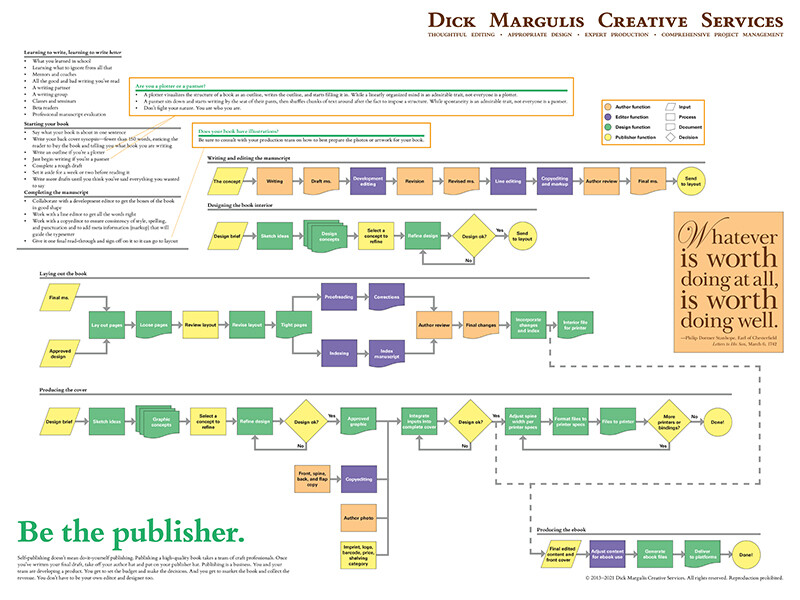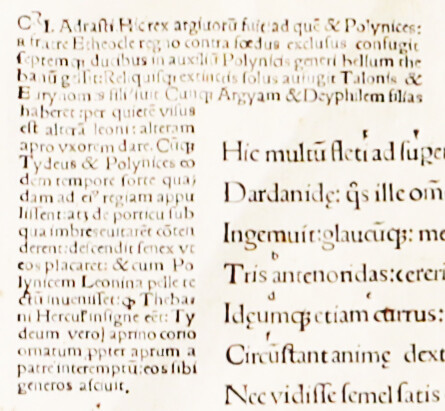A product development project
Producing a book is a product development project. As with any product, developing it consists of a series of steps organized into discrete phases:
- Concept
- Business case
- Writing
- Editing
- Publishing infrastructure
- Design
- Production
- Post-production
- Manufacturing
- Distribution
Coordinating the process is probably the least glamorous aspect, but somebody has to do it. That somebody can be you, once you learn the ropes. But on your first book, it should probably be me. You can watch over my shoulder. Mostly, I’m just keeping track so that everything gets done in the right order.

Concept
By the time you find this website, you should be well past this stage. But I’m going to ask you about it anyway. What is your book about? What is the reader going to get out of it?
The late Dan Poynter, who was a pioneer of the modern self-publishing movement, advised that the first thing an author should write is the back cover copy. That tells the reader what to expect, but it also tells the author what to write. If you can do that, great. If you can distill it down to a thirty-second elevator pitch, even better. If you can reduce that to a sentence, that’s better yet.
Business case
Why is this concept best suited to a book? Should it be an ebook instead of a printed book? Should you just publish it online for free and save the expense of turning it into a book? Would the material work better on YouTube or in a blog?
If you intend to sell the book to the public (rather than give it away to family, friends, employees, customers, prospects, . . .), is the book marketable? To what audience? How big is that audience? Why will they prefer to access your content in book form? Will they pay for it? Should it be an ebook too?
And if you’re convinced that a book is the right medium, are you also convinced that you should be the publisher and have what it takes to go that route? Or should you seek out a literary agent and see if you can attract a trade publisher instead?
Before I take you on as a client, I want to know your thinking about these questions. I want to know that you have an outline of a marketing plan or that you don’t need a marketing plan because you’re not selling the book. The last thing I want to do is produce a book for you that is going to sit in boxes in your spare bedroom reminding you that you had no plan to find other homes for them.
Writing
Knowing what you want to write about is not the same as actually writing it. You may be the world’s leading authority on your subject, and you may also be a gifted writer. But many authors are not writers, and that’s okay too.
You can learn to write. There are many ways to learn to improve your writing if you want to do that—courses, writing groups, a writing partner, workshops, textbooks, private coaches, and more. Some of these options cost nothing but your time and effort. You may also benefit from engaging a development editor to help you from the early stages of organizing your book onward.
And if you don’t have time to learn to write, you can put together a thorough outline of what you want to say and then work with a ghostwriter to flesh it out.
Ultimately, though, the quality of the manuscript you bring to the book production process influences both the cost of editing and the quality of the finished book. It influences the cost because the better shape it’s in, the faster the editing can go. And it influences the quality because editing can only make a book better; it can’t make it perfect.
Here’s the question I will ask you before you submit your final draft to me: Is this your best work? If your honest answer is “No, I can do better,” then do better. It will save you money, and you’ll end up with a better book.
The final draft of your manuscript is the formal end of the writing phase.
Editing
Once you’ve completed your final draft, take a step back. Remove your author hat and put on your publisher hat. This is a product development process, and editing is the next phase. From here forward, you are working with an editor (hopefully me) as your teammate in trying to make the manuscript as good as it can be. The editor is there to help you make the book better, not to criticize your writing. Working collaboratively with your editor is a better strategy than becoming defensive about every suggested change.
The final editing stage before a manuscript is ready for production is markup. Markup is adding metadata to the text to label the different semantic types (heading levels, list types, paragraph types, and so forth).
Publishing infrastructure
To be a publisher, you need a publishing imprint. I’ll walk you through the process of setting one up (securing a Web domain, obtaining ISBNs, and various other clerical tasks, including registering your copyright after the book is published).
You also need to put together the contents of the copyright page. Typically, I’ll do that for you on your first book. After that you can do it yourself or continue to delegate it to me.
Design
The design of your book, both inside and out, is ultimately driven by your budget and your plans for marketing and distribution. If you are planning to sell the book at a profit, then it’s my job as a designer to give you a book that can be sold at a price your customers are willing to pay. If you’ve written a memoir for your grandchildren and price is no object, I can make you a beautiful, albeit expensive, book. If you’ve written a genre novel, then you want an economically printed book that is nonetheless visually appealing.
Production
Production values are what separate run-of-the-mill formatting from professional book composition. It’s also where gremlins and glitches crop up. As the publisher, you can help by carefully reviewing pages as the work progresses.
Post-production
Once the pages are laid out, the proofreader gives them a thorough going over. At the same time, the pages go to the indexer, if the book is going to have an index.
You get to put your author hat back on when you review the draft index. The indexer’s special talent is in thinking about what a non-specialist might want to look for in the index. As the author, your contribution is in knowing what topics deserve the most coverage and which ones need to be deemphasized in the index.
When the proofreader’s corrections are implemented and the index pages are laid out, the book is as final as it is going to be before it is be printed.
Only at this stage is the book ready for conversion to an ebook (if you’re going to publish an ebook).
Manufacturing
The marketing plan dictates how many books to print and where to print them, what kind or kinds of bindings, and what types of ebook files you need. I’ll get cost estimates for you and place the print and ebook orders on your behalf.
Distribution
The marketing plan dictates how the book will be distributed too. This may include multiple channels, such as print-on-demand, direct sales, or shipment from a fulfillment warehouse.
